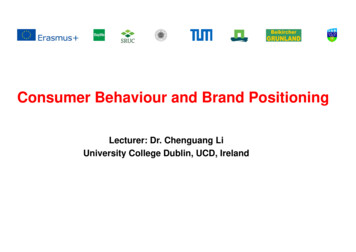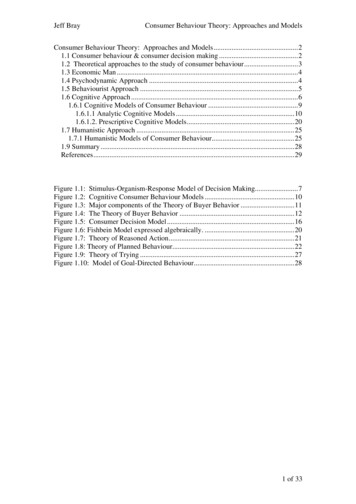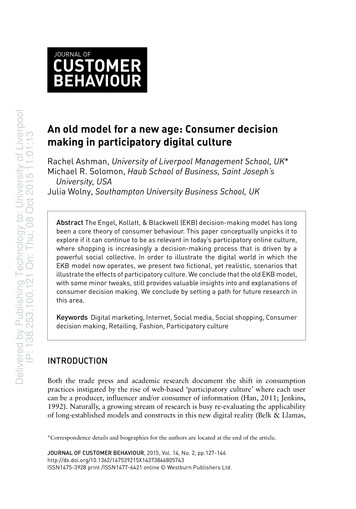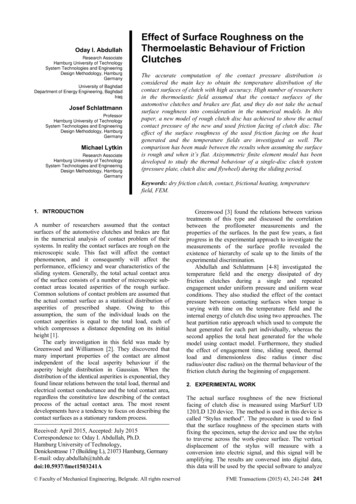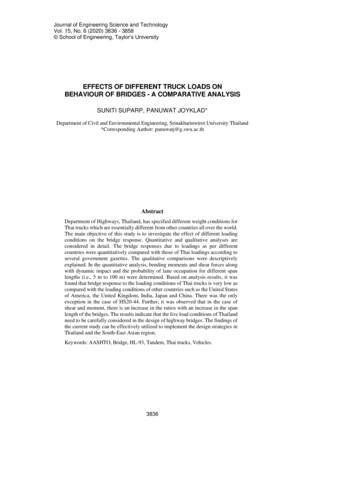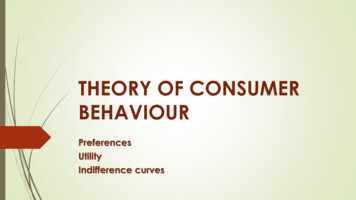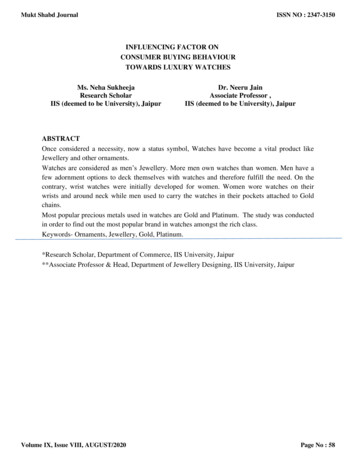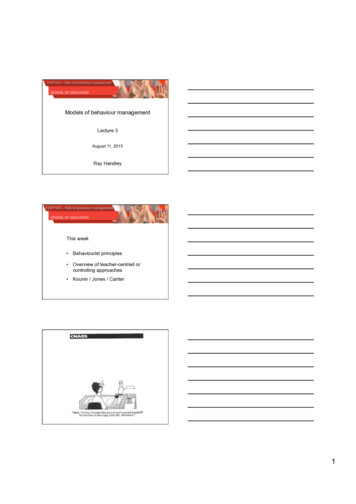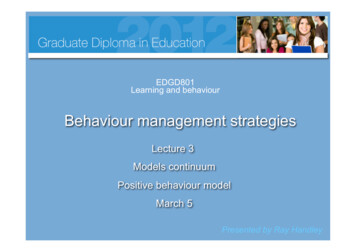
Transcription
EDGD801Learning and behaviourBehaviour management strategiesLecture 3Models continuumPositive behaviour modelMarch 5Presented by Ray Handley
This weekModels continuumAutocratic, teacher-centred approachesIntegrating learning and behaviour – KouninPositive behaviour model – JonesLimit setting – the key to discipline
The Approaches or ModelsFred Jones - Positive DisciplineJacob Kounin - Preventative disciplineCanter & Canter - Assertive DisciplineB.F. Skinner - Applied Behaviour AnalysisBill RogersDecisive DisciplineIntegrationofteaching4RsMeetingClear- psthinkingroutinesLooking for exceptionsEncouragementCostFunctionalof splanDoingit oals illiam GlasserQuality SchoolsCognitive Behavioural - Ellis, Wragg, PetersonUnderstanding behaviour - Dreikurs, BalsonHaim Ginott, Carl Rogers - Humanist approachesStrengths Based Intervention - Durrant, Kowalski
Bill RogersJacob KouninGroup ManagementDecisive DisciplineFred JonesNeo-AdlerianPositive ems TheorySolution focussedApplied BehaviourAnalysisBehaviour ModificationCanter & CanterAssertive DisciplineChoice TheoryWilliam GlasserCognitive-behaviourismModels of Behaviour Management ntLaissez-faireempoweredLimit ectivemotivation
Jacob KouninGroup ManagementFred JonesClick to viewPositive DisciplineModels of Behaviour Management ContinuumAutocraticDemocraticLaissez-faireLimit SettingLeadershipNon-directive
Preventive Discipline - Jacob Kounin teaching and discipline need to be integrated interested, stimulated and active learners reduce the risk ofdisruptive behaviour planned and coordinated activities within lessons reducethe likelihood of disruptive behaviour a positive, productive classroom atmosphere or tone ispervasive for all participants
Preventive Discipline - Jacob Kounin Ripple effect Withitness Overlapping Smoothness Momentum Group alerting By correcting misbehaviours in onestudent, it often influences the behaviourof nearby students Conversely, noticing positive behaviour inone or a small group of students drawsthe attention of the others to yourexpectationsKounin, Jacob S. (1970) Discipline and Group Management in Classrooms. Holt, Rinehart and Winston, Inc.TEXT from http://wik.ed.uiuc.edu/index.php/Kounin, Jacob
Preventive Discipline - Jacob Kounin Ripple effect Withitness Overlapping Smoothness Momentum Group alerting Always be alert to sights and sounds in theclassroom. Arrange the seats so that students arealways within eyesight. Scan the room when working withindividuals or small groups of students.When helping an individual make sure thatyou do not have your back to the rest of theclass. Briefly acknowledge misbehavior at firstdetection to let the class know that youknow. Do not let the misbehaviour escalatebefore action is taken.Kounin, Jacob S. (1970) Discipline and Group Management in Classrooms. Holt, Rinehart and Winston, Inc.TEXT from http://wik.ed.uiuc.edu/index.php/Kounin, Jacob
Preventive Discipline - Jacob Kounin Ripple effect Withitness Overlapping Smoothness Momentum Group alerting When instructing one group, the teachershould be able to acknowledge difficultiesthat students outside of the group may behaving so that instruction continues moving. This also includes distractions from outsidethe classroom such as notes from the officeor students walking through the hallways.Kounin, Jacob S. (1970) Discipline and Group Management in Classrooms. Holt, Rinehart and Winston, Inc.TEXT from http://wik.ed.uiuc.edu/index.php/Kounin, Jacob
Preventive Discipline - Jacob Kounin Ripple effect Withitness Overlapping Smoothness Momentum Group alerting Preplan the lesson so that extraneousmatters are realised ahead of time andtaken care of. Supplies for the class shouldalways be preorganised before class beginsand close to where they will be used. Once students are doing their work andengaged, do not distract them. Leave themto their work and assist individuals withquestions or needs.Kounin, Jacob S. (1970) Discipline and Group Management in Classrooms. Holt, Rinehart and Winston, Inc.TEXT from http://wik.ed.uiuc.edu/index.php/Kounin, Jacob
Preventive Discipline - Jacob Kounin Ripple effect Withitness Overlapping Smoothness Keep the lesson moving briskly. Not over-dwell on a minor or alreadyunderstood concept. Correct students without nagging andquickly return to the lesson. Have students move from one activity tothe next without being forced to wait foreach other and each step in the transition. Momentum Group alertingKounin, Jacob S. (1970) Discipline and Group Management in Classrooms. Holt, Rinehart and Winston, Inc.TEXT from http://wik.ed.uiuc.edu/index.php/Kounin, Jacob
Preventive Discipline - Jacob Kounin Ripple effect Withitness Overlapping Smoothness Momentum Calling on students at random by asking aquestion only after scanning the room tomake sure students are paying attention.Raising group interest by interspersingsuspense between questions.Having the entire class respond in unison.Physically moving around the room andasking students to show what they havedone.Asking one student to respond and lookingat others. Group alertingKounin, Jacob S. (1970) Discipline and Group Management in Classrooms. Holt, Rinehart and Winston, Inc.TEXT from http://wik.ed.uiuc.edu/index.php/Kounin, Jacob
Positive Discipline - Fred JonesClassroom management procedures must . . . . be positive and gentle. set limits and build cooperation in the absence of coercion be economical, practical and simple ultimately reduce the teacher's work load. offer incentives and encouragement for positive effortJones, Fred (2000) Tools for Teaching. Santa Cruz, CA: Frederick Jones and Associates.
Positive Discipline - Fred JonesThree different management methods are integrated to forma three-tier approach to discipline management. Limit-settingʻlimit-setting andrelationship building forma tier of the managementsystem which we mightbest describe as theinterpersonal-interactivelevel of management.ʼfrom http://www.fredjones.com/Positive Discipline/Discipline Ch18.html
Positive Discipline - Fred JonesThree different management methods are integrated to forma three-tier approach to discipline management. Limit-setting Incentive systemsmake the exchange ofpositive and negativesanctionsprearranged, explicit,concrete, and public.from http://www.fredjones.com/Positive Discipline/Discipline Ch18.html
Positive Discipline - Fred JonesThree different management methods are integrated to forma three-tier approach to discipline management. Limit-setting Incentive systems Back-up systemsnegative sanctionsprovide a disincentive,and the reinforcementof appropriatebehavior is left tochance.from http://www.fredjones.com/Positive Discipline/Discipline Ch18.html
Positive Discipline - Fred JonesThere are seven steps in limit setting: Eyes in the back of your head
Positive Discipline - Fred JonesThere are seven steps in limit setting: Eyes in the back of your head Terminate InstructionStop what you are doing andconcentrate on the disruption
Positive Discipline - Fred JonesThere are seven steps in limit setting: Eyes in the back of your headFace the student, make eyecontact, and remain calm Terminate Instruction Turn, look, and say the studentʼs name
Positive Discipline - Fred JonesThere are seven steps in limit setting: Eyes in the back of your head Terminate InstructionWalk calmly to the front of thestudentʼs desk and avoid comments Turn, look, and say the studentʼs name Walk to the edge of the studentʼs desk
Positive Discipline - Fred JonesThere are seven steps in limit setting: Eyes in the back of your head Terminate InstructionDemonstrate what is expected Turn, look, and say the studentʼs name Walk to the edge of the studentʼs desk Prompt
Positive Discipline - Fred JonesThere are seven steps in limit setting: Eyes in the back of your head Terminate Instruction Turn, look, and say the studentʼs name Walk to the edge of the studentʼs desk Prompt PalmsLean towards the student
Positive Discipline - Fred JonesThere are seven steps in limit setting: Eyes in the back of your head Terminate InstructionShift and maintain eye contact toshow you are still aware Turn, look, and say the studentʼs name Walk to the edge of the studentʼs desk Prompt Palms Camping out
Setting limitsRedirecting students back to their behaviour andcreating a dilemma for which a decision is neededSetting a limit is not the same asissuing an ultimatum."If you donʼt finish the workyou will stay back at lunch.
Setting limitsRedirecting students back to their behaviour andcreating a dilemma for which a decision is neededSetting a limit is not the same asissuing an ultimatum."You can finish the work now and go outto lunch with the others or if it isunfinished you will stay back at lunchand I can help you with it. You decide.
Setting limitsRedirecting students back to their behaviour andcreating a dilemma for which a decision is neededSetting a limit is not the same asissuing an ultimatum."The purpose of limits is to teach,not to punish."Through limits, people begin to understand that their actions,positive or negative, result in predictable consequences. Bygiving such choices and consequences, a structure for gooddecision making is provided."
Setting limitsRedirecting students back to their behaviour andcreating a dilemma for which a decision is neededSetting a limit is not the same asissuing an ultimatum."The purpose of limits is to teach,not to punish."Setting limits is more about listeningthan talking. By listening, you will learn more about whatʼsimportant to students, and that will help you setmore meaningful limits."
Setting limitsExplain which behaviouris inappropriate"Be prepared to enforceyour consequences.Allow time.Ste5ps"Explain why the behaviouris inappropriate.Give reasonable choices "with consequences.
Choice Theory William Glasser Humanism Ginott/Rogers Neo-Adlerian Balson/Dreikurs Systems Theory Solution focussed Bill Rogers Decisive Discipline Internal motivation Autocratic Limit Setting Democratic Leadership Laissez-faire Non-directive Models of Behaviour Management Continuum Jacob Kounin Group Management. Fred Jones Positive Discipline Autocratic Limit Setting Democratic Leadership .
